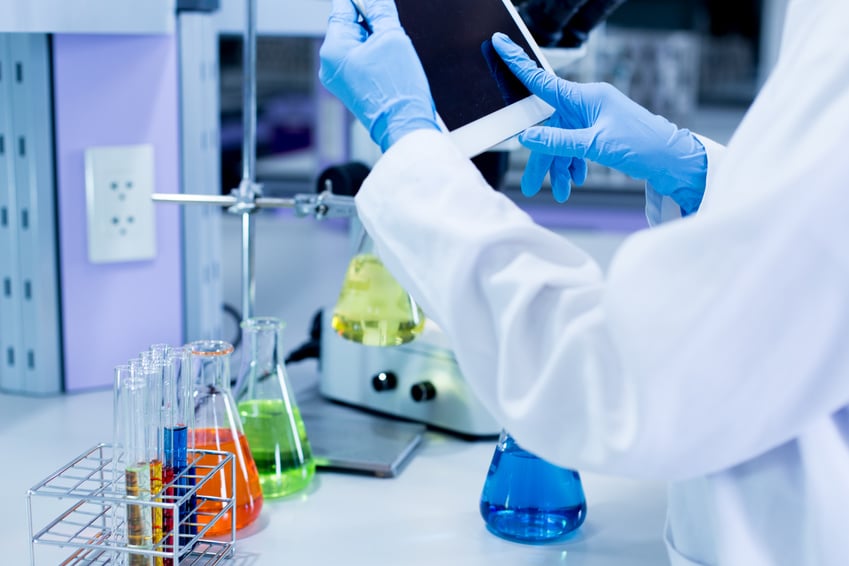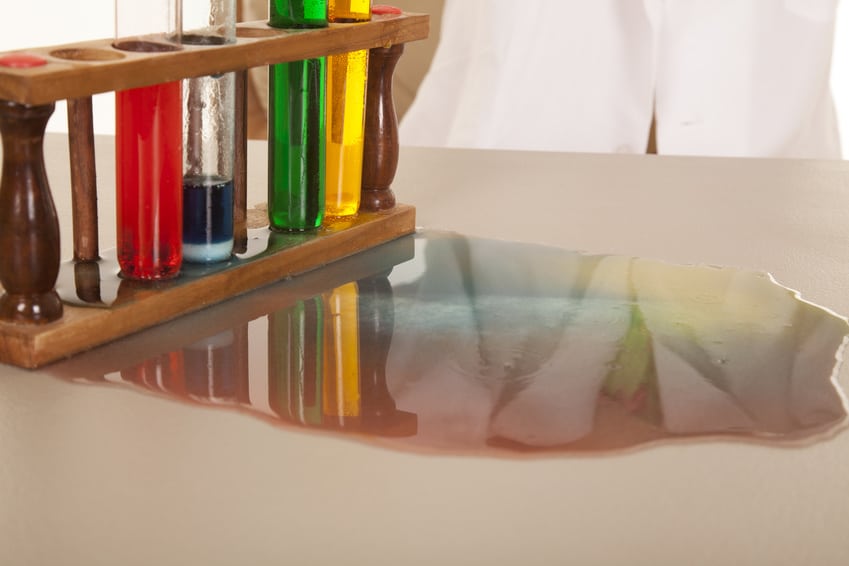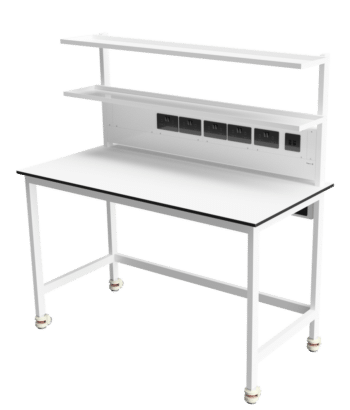[vc_row equal_height=”yes” content_placement=”middle”][vc_column][vc_column_text]From time to time, chemical spills will occur in the laboratory and if handled properly, they will be nothing more than a nuisance. However, chemical spills can be seriously disruptive and in the worse cases can cause damage or injury.
Most spills will involve small amounts of known material and cleaning these up will involve a low level of risk if proper precautions are taken. Users of the lab are best positioned to clean these spills as they will know the substance and be able to respond quickly.
However, for some spills, outside assistance should be sought – this may include occasions when a large amount of a substance is spilt or where the substance presents a greater hazard. Users should err on the side of caution – it is better to take this approach than to risk someone’s health or even their life.
A proper response to spills should include thorough planning and the availability and use of necessary clean up equipment. In turn, this will reduce costs, in terms of both injuries and money. These tips are designed to be used alongside regulatory compliance advice, rather than to replace it.
Quick Navigation
- Proper Information and Equipment
- Taking Action
- When to call the Fire Service
- Tackling known chemicals
- Cleaning up the spill
- Disposal
Proper Information and Equipment
The starting point of any spillage plan is a risk assessment – which chemicals will be handled within the lab?
Every lab should have a spillage kit that is appropriate for the type of chemicals handled. A number of different kits are available – these include absorbable spill pillows to be placed in, over or around the spill, collapsible mops with absorbent pads, acid and alkali neutralisers, inactivators, chemical absorbents, absorbent granules and chemical granules.

Note that each kit has its own application and won’t be suitable for all uses. Spill pillows, for example, aren’t typically used for concentrated corrosive acids where an acid neutraliser or absorbent granules are required.
Suitable personal protective equipment should also be provided. This might include respirators, gloves with wide chemical resistance (not latex), eye protection and a chemical resistance gown or apron. Note that while nitrile gloves provide good overall protection; PVC, neoprene or butyl gloves will offer better protection against particular chemicals such as certain concentrated acids.
A team member should be made responsible for ensuring that all spill kits and protective equipment is maintained and that all lab users know where to find it and how to use it.
Additionally, details of how to handle particular spillages of hazardous chemicals (including which kit/equipment is most appropriate in each case) should be readily available.
Taking Action
The first step when a spill occurs is for the first person on the scene to notify other laboratory users/visitors about the spill and to advise them to maintain a safe distance.
The next step is to decide whether the spill is sufficiently serious to require evacuation and notification to the fire service (usually by setting off the fire alarm), or whether the spill can be controlled.
When to Call the Fire Service
Where the spill involves a chemical that is unknown or it has been previously identified at risk assessment stage that users will be unable to safely deal with it (a large spill of Formaldehyde, for example) the fire service should be immediately notified. Users may also feel unable to deal with larger spills and seek either senior assistance or if unavailable, the fire service’s assistance.
If there are no users within the lab who are trained to use the spillage kit and personal protective equipment provided, again, the fire service should be summoned.
The location of the spill can be important to your decision – for example, it may be in a radiation hazard or biological hazard area and in such cases, both the fire service and the appropriate supervisors for these areas should be notified.
If the fire service is called, the first person on the scene should be responsible for awaiting their arrival and informing them of the nature of the spill.
Tackling Known Chemicals

Where (a) the chemical spilt is known to laboratory users (b) there is a spill kit and protective equipment available and (c) users of the lab are trained in using the spill kit and equipment, the spill can be dealt with by the users without the need for external help.
At all times, it is important to err on the side of caution – if users are not confident in dealing with the particular chemical or the size of the spill, external help should be sought immediately rather than chances taken.
If the decision is to control the spillage, a careful assessment must be made of the situation. The lab user who has taken charge must inform others that they intend to deal with the spill and then, assisted by another trained lab user, the spill can be managed. It is desirable for a third person to observe the clean-up operation from a safe distance so that they can spot any developing hazard and ensure others steer clear of the area.
Cleaning up the Spill
The process starts with isolating the spill – this can be achieved by sealing off the area and putting up warning signs. If the chemical may seep through to the floor below, ensure anyone working on a floor under the lab is informed and immediately evacuated.
To stop the spread of fumes, it is desirable to close the doors while ensuring the area is well ventilated by opening the windows. However, you should not move further into the room or cross the spill to do this. If possible ask those occupying adjacent rooms to close the doors.
Where the liquid is flammable, it is essential that naked flames are immediately put out. The electricity supply to the area should be cut while the spill is being dealt with but this should never be done using switches as these can generate a spark.
Once initial precautions have been taken, you can assemble the necessary equipment required to deal with the spill and put on suitable personal protective equipment. This ideally should be done in a safe adjacent room. As noted above, certain choices of equipment (such as gloves) may depend on the chemical you are handling.
If, after attempting to clean the spill you notice that the vapours are penetrating your respirator, you can still detect the chemical smell, you should immediately leave the area and call the fire service.
Disposal
Once the spill has been cleaned, you will need to dispose of the chemical waste appropriately. The person in charge of the spill should continue wearing personal protective equipment throughout this process. The waste may be confined to an appropriate container with a tight-fitting bag or a sealable plastic bag, depending on the chemical. If the chemical waste is fuming or volatile, before sealing the container or bag it should be placed in a fume cupboard (but not in a recirculating model) so that the fumes can fully evaporate first.
All surfaces that were contaminated by the spill must be cleaned thoroughly. The personal protective equipment will then need to be cleaned or disposed of. The gloves should be removed first and dealt with before the respirator and eye protection are removed as the gloves may have some of the spill left on them.
At InterFocus we design and manufacture progressive labs with comprehensive safety features. For more information about our bespoke fitted labs, visit our homepage or call our team on 01223 894 833.



